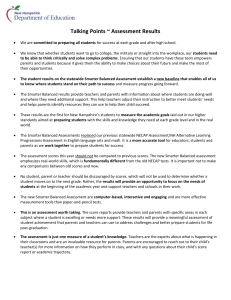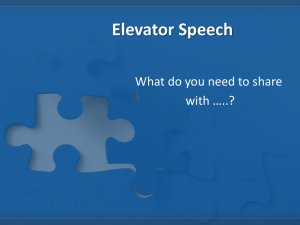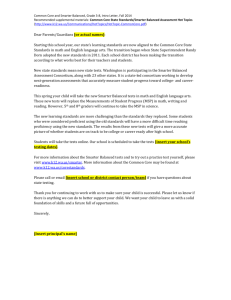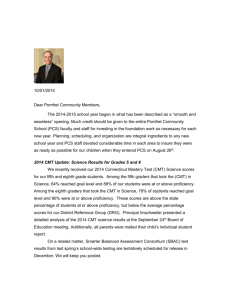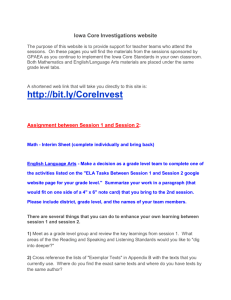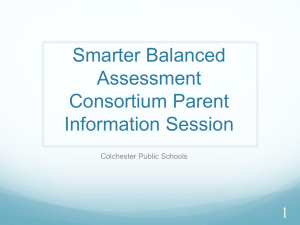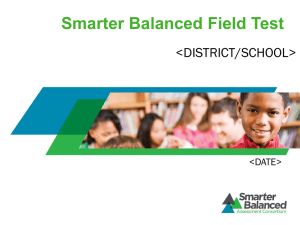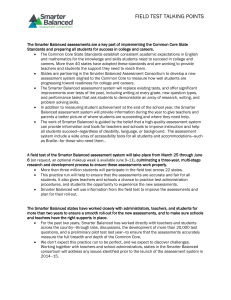Connecticut Mastery Test Smarter Balanced Assessment
advertisement
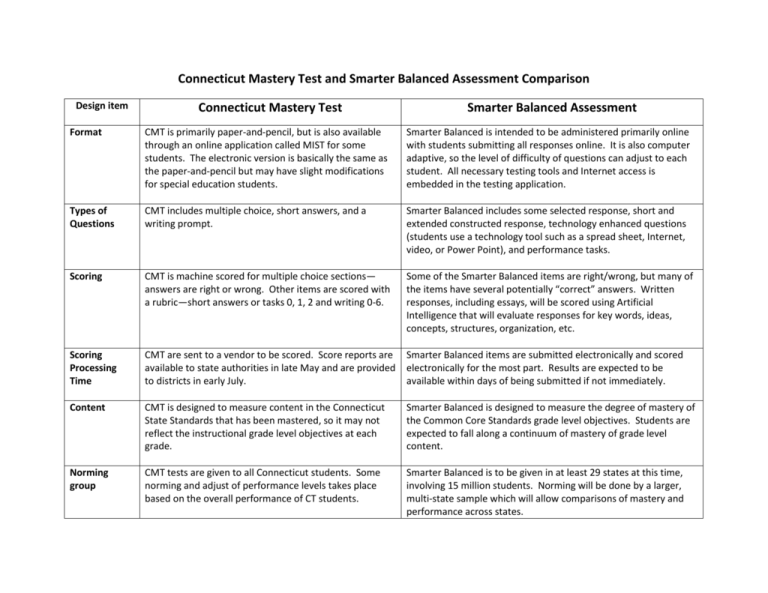
Connecticut Mastery Test and Smarter Balanced Assessment Comparison Design item Connecticut Mastery Test Smarter Balanced Assessment Format CMT is primarily paper-and-pencil, but is also available through an online application called MIST for some students. The electronic version is basically the same as the paper-and-pencil but may have slight modifications for special education students. Smarter Balanced is intended to be administered primarily online with students submitting all responses online. It is also computer adaptive, so the level of difficulty of questions can adjust to each student. All necessary testing tools and Internet access is embedded in the testing application. Types of Questions CMT includes multiple choice, short answers, and a writing prompt. Smarter Balanced includes some selected response, short and extended constructed response, technology enhanced questions (students use a technology tool such as a spread sheet, Internet, video, or Power Point), and performance tasks. Scoring CMT is machine scored for multiple choice sections— answers are right or wrong. Other items are scored with a rubric—short answers or tasks 0, 1, 2 and writing 0-6. Some of the Smarter Balanced items are right/wrong, but many of the items have several potentially “correct” answers. Written responses, including essays, will be scored using Artificial Intelligence that will evaluate responses for key words, ideas, concepts, structures, organization, etc. Scoring Processing Time CMT are sent to a vendor to be scored. Score reports are available to state authorities in late May and are provided to districts in early July. Smarter Balanced items are submitted electronically and scored electronically for the most part. Results are expected to be available within days of being submitted if not immediately. Content CMT is designed to measure content in the Connecticut State Standards that has been mastered, so it may not reflect the instructional grade level objectives at each grade. Smarter Balanced is designed to measure the degree of mastery of the Common Core Standards grade level objectives. Students are expected to fall along a continuum of mastery of grade level content. Norming group CMT tests are given to all Connecticut students. Some norming and adjust of performance levels takes place based on the overall performance of CT students. Smarter Balanced is to be given in at least 29 states at this time, involving 15 million students. Norming will be done by a larger, multi-state sample which will allow comparisons of mastery and performance across states. Testing time CMT tests have specific time frames for each section of the test. Up to two sections can be given in one day. Most schools complete testing in about two weeks with additional time for make-ups and special modifications. Smarter Balanced summative testing is spread over a twelve week window to allow districts flexibility in scheduling students online in large and/or small groups. Sections do have specific time requirements, but because many questions are computer adaptive, some students may take different amounts of time to complete their sessions. Use of test data CMT data are summative. Information about student performance is not available before the end of the school year, so it is not actionable. It does inform the previous teacher about overall strengths and weaknesses so that curriculum and instructional focus can be adjust for the next group. It also provides the new teacher with baseline data from March on the students’ performance level. Smarter Balanced can be formative or summative. Teachers can use items from the test bank throughout the school year to get information on how well students are mastering content and adjust instruction to work on mastering tougher concepts. During the summative period, a student’s cumulative level of mastery is determined for reporting purposes. Test setting and security CMT is given as a whole class, whole group setting. It is governed by strict testing protocols to assure that all students have the same directions, time, and appropriate testing environment. Smarter Balanced is given using a technology interface, so the testing protocols are more flexible. Districts and schools will decide how to cycle classes and grades through the available technology to be sure that there is adequate bandwidth and access to a device/interface for students testing. Classes may test at once or break into smaller groups since all directions and prompts are available through the computer. Since the tests are computer adaptive, students probably will not all have the same questions and all tools are embedded so students cannot access inappropriate resources. Assessment can be woven into the classroom setting—will seem more like the instructional process than stop everything and test. Students will have certain times when they will be allowed to have discussions and collaborate before working on their individual responses to be submitted online.
